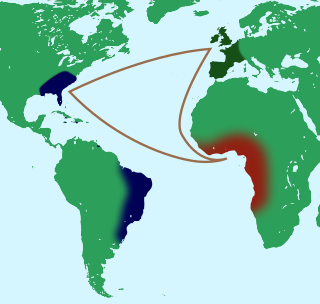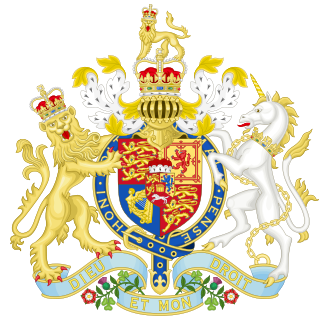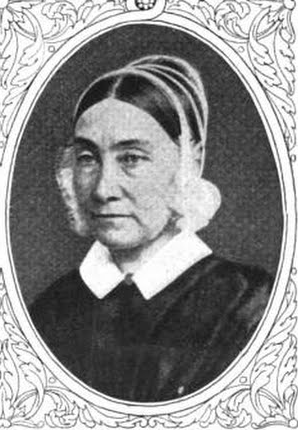
Abolitionism, or the abolitionist movement, is the movement to end slavery. In Western Europe and the Americas, abolitionism was a historic movement that sought to end the Atlantic slave trade and liberate enslaved people, which eventually spread to eradicate slavery from the entire world.

The Atlantic slave trade or transatlantic slave trade involved the transportation by slave traders of enslaved African people, mainly to the Americas. The slave trade regularly used the triangular trade route and its Middle Passage, and existed from the 16th to the 19th centuries. The vast majority of those who were transported in the transatlantic slave trade were people from Central and West Africa who had been sold by other West Africans to British, Portuguese and French slave traders. while others had been captured directly by the slave traders in coastal raids; Portuguese and british gathered and imprisoned the enslaved at forts on the African coast and then brought them to the Americas. Except for the Portuguese, European slave traders generally did not participate in the raids because life expectancy for Europeans in sub-Saharan Africa was less than one year during the period of the slave trade.

The Middle Passage was the stage of the Atlantic slave trade in which millions of enslaved Africans were transported to the Americas as part of the triangular slave trade. Ships departed Europe for African markets with manufactured goods, which were then traded for slaves with rulers of African states and other African slave traders. Slave ships transported the slaves across the Atlantic. The proceeds from selling slaves was then used to buy products such as hides, tobacco, sugar, rum, and raw materials, which would be transported back to northern Europe to complete the triangle.

The Slave Trade Act 1807, officially An Act for the Abolition of the Slave Trade, was an Act of the Parliament of the United Kingdom prohibiting the slave trade in the British Empire. Although it did not abolish the practice of slavery, it encouraged British action to press other nation states to abolish their own slave trades.

Slavery in the British and French Caribbean refers to slavery in the parts of the Caribbean dominated by France or the British Empire.

Slave ships were large cargo ships specially built or converted from the 17th to the 19th century for transporting slaves. Such ships were also known as "Guineamen" because the trade involved human trafficking to and from the Guinea coast in West Africa.

Slavery has historically been widespread in Africa. Systems of servitude and slavery were common in parts of Africa in ancient times, as they were in much of the rest of the ancient world. When the trans-Saharan slave trade, Indian Ocean slave trade and Atlantic slave trade began, many of the pre-existing local African slave systems began supplying captives for slave markets outside Africa. Slavery in contemporary Africa is still practiced despite it being illegal.

The abolition of slavery occurred at different times in different countries. It frequently occurred sequentially in more than one stage – for example, as abolition of the trade in slaves in a specific country, and then as abolition of slavery throughout empires. Each step was usually the result of a separate law or action. This timeline shows abolition laws or actions listed chronologically. It also covers the abolition of serfdom.

The importation of enslaved Africans to what became New York began as part of the Dutch slave trade. The Dutch West India Company imported eleven African slaves to New Amsterdam in 1626, with the first slave auction held in New Amsterdam in 1655. With the second-highest proportion of any city in the colonies, more than 42% of New York City households held slaves by 1703, often as domestic servants and laborers. Others worked as artisans or in shipping and various trades in the city. Slaves were also used in farming on Long Island and in the Hudson Valley, as well as the Mohawk Valley region.

The World Anti-Slavery Convention met for the first time at Exeter Hall in London, on 12–23 June 1840. It was organised by the British and Foreign Anti-Slavery Society, largely on the initiative of the English Quaker Joseph Sturge. The exclusion of women from the convention gave a great impetus to the women's suffrage movement in the United States.

Abolitionism in the United Kingdom was the movement in the late 18th and early 19th centuries to end the practice of slavery, whether formal or informal, in the United Kingdom, the British Empire and the world, including ending the Atlantic slave trade. It was part of a wider abolitionism movement in Western Europe and the Americas.

Word by Word: Emancipation and the Act of Writing is a 2013 historical book and analysis of a collection of writings by American slaves and befreed slaves. It was written by Christopher Hager and published by Harvard University Press.
Manisha Sinha is an Indian-born American historian, and the Draper Chair in American History at the University of Connecticut. She is the author of The Slave's Cause: A History of Abolition (2016), which won the Frederick Douglass Book Prize.
The Colored Female Religious and Moral Society was an African American women's club organized in 1818 in Salem, Massachusetts. The group was started by forty women and they created their own constitution. The group's constitution was published in the Liberator, an abolitionist paper. The members promised that they would "be charitably watchful over each other." Members also were required to take an oath of secrecy. The organization was religious in nature, but they also worked to get sickness and death benefits for others. In 1833, after membership had dwindled, the society was again revived. Many of the members were "Christian propertied elite."

Sarah Pugh was an American abolitionist, activist, suffragist, and teacher. She was involved with promoting the free produce movement, including a boycott on sugar produced by slave labor. She was a leader of the Philadelphia Female Anti-Slavery Society from its earliest days in 1835 until it closed in 1870. Along with Lucretia Mott, Pugh was one of the delegates to the World Anti-Slavery Convention in London who were denied their seats because they were women.
On June 19, 1838, the Maryland Province of the Society of Jesus agreed to sell 272 slaves to two Louisiana planters, Henry Johnson and Jesse Batey, for $115,000. This sale was the culmination of a contentious and long-running debate among the Maryland Jesuits over whether to keep, sell, or free their slaves, and whether to focus on their rural estates or on their growing urban missions, including their schools.
William Hamilton was a prominent African-American orator and civil rights activist, based in New York City. He was born to a free black woman and was reputed to be a natural son of Alexander Hamilton, the Founding Father. William Hamilton is best known as a leader in the first wave of American abolitionism.

The Common Wind: Afro-American Currents in the Age of the Haitian Revolution is a 2018 book by Julius S. Scott, based on his influential but previously unpublished 1986 Duke University doctoral dissertation. The book traces the circulation of news in African diasporic communities in the Caribbean around the time of the Haitian Revolution, and links the "common wind" of shared information to political developments leading to the abolition of slavery in the British and French Caribbean.
David Cooper was an American farmer, Quaker, pamphleteer and an author of abolitionist ideals in the latter 1700s. A native of New Jersey, he lived the greater part of his life in and around Gloucester and Salem, New Jersey. Cooper was vocal on the issue of slavery and was devoted to the abolitionist movement before, during and after the American Revolution. As a devoted Christian and Quaker, he made numerous comparisons between abolition and Biblical thought in his writings, orations and orations. By submitting pamphlets and petitions, Cooper appealed to and encouraged George Washington and the Congress to make efforts to abolish slavery. He is noted for writing a 22-page anti-slavery tract addressed to the "Rulers of America", which was distributed to members of Congress, a copy of which Washington signed and kept in his personal library.

A Tribute for the Negro: Being a Vindication of the Moral, Intellectual, and Religious Capabilities of the Coloured Portion of Mankind; with Particular Reference to the African Race is an 1848 work written by the Leeds-based British abolitionist Wilson Armistead, that published indictments of scientific racism, as well as slavery, and included biographies of a number of prominent campaigners including Henry Highland Garnet and Phyllis Wheatley. It was one of a number of anti-slavery books published in the 1800s by social reformers. The book was dedicated to James Pennington, Frederick Douglass, Alexander Crummell, "as well as many other elevated noble examples of elevated humanity of the negro". Its purpose was to argue and present evidence for the accomplishments of African Americans and act as a treatise of support. One of the didactic tools used by Armistead in the book is to draw comparisons between Britain's Roman past and its cruelties, to argue for more progressive views on abolition.















